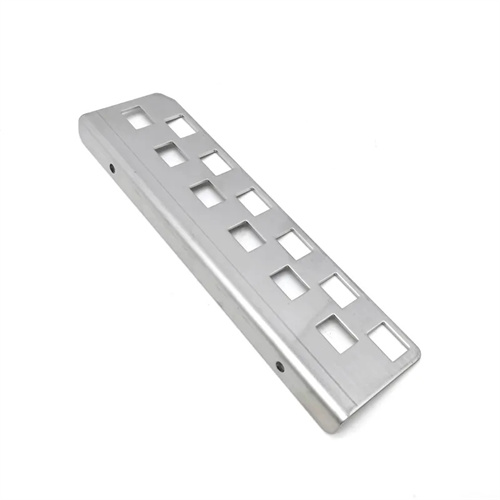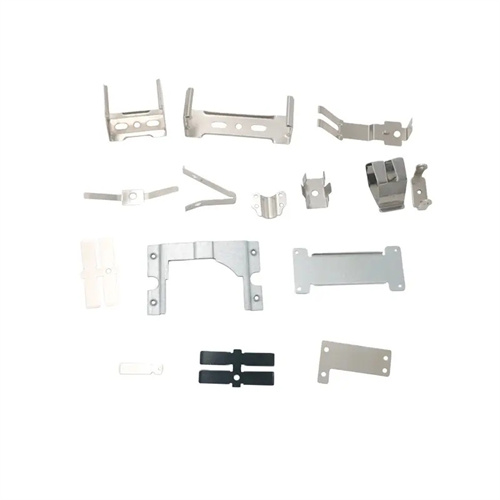Blanking deformation process
The blanking deformation process is a plastic working process that utilizes the shearing action between the punch and die of a die to separate the sheet metal. Essentially, it involves a continuous process of deformation under shear forces: elastic deformation, plastic deformation, and fracture separation. While this process is brief, typically completing within milliseconds, it involves complex mechanical phenomena and material behavior, significantly impacting the quality of stamped parts and the lifespan of the die. A thorough understanding of the characteristics of each stage of the blanking deformation process can help optimize die design and process parameters, improving the precision and production efficiency of blanked parts.

The first stage of blanking deformation is elastic deformation. When the punch contacts the sheet and begins its downward movement, the sheet is squeezed by the punch and die, resulting in elastic compression and bending deformation. At this point, the stress within the sheet has not yet reached the material’s yield point. The sheet is slightly concave below the punch and slightly upward above the die. Minor elastic deformation occurs in the contact areas between the punch, die, and die. As the punch continues to press downward, the deformation of the sheet gradually increases, and stress concentration begins to occur at the edges of the punch and die. The stress gradient is distributed across the sheet thickness, with the highest stress near the edges. This elastic deformation stage lasts for a short time, and the extent of deformation depends on the sheet’s elastic modulus and thickness, as well as the gap between the punch and die. The larger the gap, the more pronounced the elastic bending deformation. If the punch is stopped during this stage, the sheet will return to its original shape, without permanent deformation.

As the punch continues to press downward, the stress within the sheet metal reaches the material’s yield point, and the blanking deformation enters the plastic deformation stage. At this point, the sheet metal undergoes plastic shear deformation near the cutting edge, resulting in significant plastic flow. The punch gradually squeezes into the sheet metal, while the die cutting edge begins to cut into the other side of the sheet metal. The main characteristics of the plastic deformation stage are permanent deformation of the sheet metal, visible signs of plastic flow on the shear surface, and the deformation area gradually expanding toward the center of the sheet metal. During this stage, the stress distribution within the sheet metal is complex. In addition to shear stress, there are also tensile and compressive stresses caused by bending deformation. The combined effect of these stresses causes uneven plastic deformation of the sheet metal, with the greatest degree of deformation near the cutting edge. The extent of plastic deformation is related to the plasticity of the material, the punch-die gap, and the punching speed. Materials with good plasticity have a longer plastic deformation stage and produce a better shear surface quality. However, excessively large or small gaps exacerbate deformation unevenness, resulting in burrs or tears on the shear surface.

As the punch presses further downward, the sheet’s plastic deformation reaches its limit, and microcracks first appear near the punch and die cutting edges, signaling the entry of the fracture separation stage. Microcracks initially originate on the sheet’s surface at the punch and die cutting edges and then propagate inward, along the direction of maximum shear stress at a 45-degree angle to the shear force. When the microcracks on the upper and lower sides meet and penetrate, the sheet separates, forming the blanked part and scrap. The fracture separation stage is characterized by a sudden break in the material, accompanied by elastic recovery, resulting in some springback. The quality of the fracture surface depends on the crack propagation path. If the cracks extend in a straight line, the fracture surface is smooth; if the crack propagation path is tortuous, the fracture surface is rough, even exhibiting tears and burrs. The punch-die clearance is a key factor influencing the quality of the fracture separation. An appropriate clearance ensures smooth alignment of the upper and lower cracks, minimizing burrs and tears. Excessively large or small clearances can lead to crack misalignment, compromising the quality of the blanked part’s cross-section.

Although the three stages of the blanking deformation process are clearly defined, they are actually continuous, with no noticeable time intervals between them. The duration of the entire process is related to the stamping speed, sheet thickness, and material properties. The thicker the sheet and the higher the strength, the longer the blanking deformation process takes. In actual production, the blanking deformation process is also affected by factors such as the sharpness of the die cutting edge and lubrication conditions. Edge wear can weaken the stress concentration effect, prolong the elastic and plastic deformation stages, and delay the fracture separation stage, thereby increasing the blanking force and generating larger burrs. Therefore, optimizing the die structural parameters, reasonably selecting the process conditions, and controlling the various stages of the blanking deformation process are the key to improving the quality of blanked parts and the life of the die.
